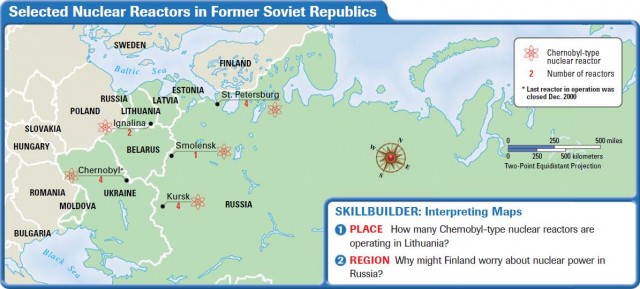The Soviet Union’s Nuclear Legacy
As you have read, the breakup of the Soviet Union sparked regional conflicts and economic hardship. Equally serious were the problems caused by the Soviet Union's nuclear programs. These included nuclear warheads atop ballistic missiles, poorly constructed and maintained nuclear power stations, and decaying nuclear waste dumps. All threatened the region's people and environment.
An Unwelcome Legacy
When the USSR fell apart in the early 1990s, leaders around the world had serious concerns about the fate of the region's nuclear weapons. The Soviet Union, which had once controlled those weapons, was now separated into 15 independent republics. World leaders wanted to know who was in control of the weapons, where they were located, and how well they were protected. They also wondered what would become of the nuclear scientists who had worked on the weapons systems.
The weapons industry was just part of the problem. As the 1986 disaster at Chernobyl had so clearly shown, many of the region's nuclear reactors were badly built and poorly managed. Many reactors of the same design as the one that exploded at Chernobyl still exist. Observers fear another disaster may occur in the region.

The Consequences of Collapse
The nuclear legacy of the USSR has had serious political, economic, and environmental consequences.
POLITICAL TENSIONS
When the communist government could no longer keep the USSR together, the security of the region's nuclear materials became uncertain. This has caused political tension between the region's leaders and other nations, especially the United States.
In January 2000, a task force of former U.S. officials issued a report that suggested just how important the issue is. The report said that the possibility of Russian nuclear materials being stolen or misused is “the most urgent unmet national security threat” facing the United States. The task force recommended a $30 billion program to help ensure the safety of Russia's nuclear weapons.
ECONOMIC HEALTH
The Soviet Union's nuclear legacy also affects the economic health of Russia and the former Soviet Republics. For example, many regional leaders have been reluctant to shut down aging Soviet reactors because of the expense of building new plants that run on other kinds of fuel, such as natural gas.
Some republics have taken questionable steps to revive their economies. For instance, Russian lawmakers recently approved plans to make their country the world's nuclear dump. In January 2001, the Duma, or legislature, gave preliminary approval to a plan to import, store, and treat nuclear waste from other countries. Officials hope the project will earn Russia as much as $21 billion over the next ten years.
ENVIRONMENTAL PROSPECTS
Plans for the disposal of other nations' nuclear waste angered Russian environmentalists. But other developments have given some hope that the region's environmental prospects might improve. In December 2000, the government of Ukraine finally shut down the last active reactor at Chernobyl. Officials there pledged to spend millions of dollars on a new protective dome for the site.
Help has also come from overseas. In October 2000, a U.S.-funded treatment plant opened near the White Sea. The 17-million-dollar facility will treat radioactive waste from Russia's fleet of nuclear submarines—waste that used to be dumped in the sea.
You will learn more about these developments as you examine the primary sources and complete the Case Study Project on the following pages.
- Russia and the Republics: The Struggle for Economic Reform
- Russia and the Republics: Regional Conflict
- Russia and the Republics: Central Asia
- Russia and the Republics: Transcaucasia
- Russia and the Western Republics
- Russia and the Republics: Human-Environment Interaction
- Russia and the Republics: Climate and Vegetation
- Russia and the Republics: Landforms and Resources